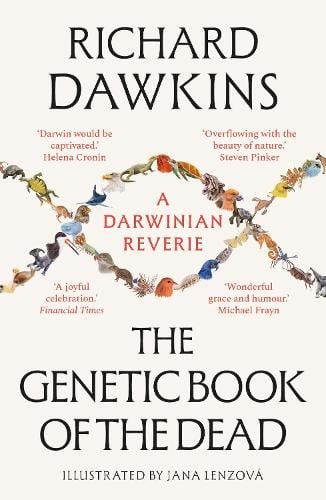The Genetic Book of the Dead


Finished — 2025-08-19
Started — 2024-12-31
Dawkins is of course the author who kicked off my adult nonfiction reading habit, and I’ll always read his new book when it comes out. I don’t know how many more times that will happen, if any. But I found “a sense of wonder” in his explication of how the immortal gene works, stumbling into the invention of such a vast and strange array of organisms along the way.
Sir D’Arcy Thompson (1860–1948), that immensely learned zoologist, classicist, and mathematician, made a remark that seems trite, even tautological, but it actually provokes thought. ‘Everything is the way it is because it got that way.’
The primatologist Richard Wrangham has promoted the intriguing hypothesis that the invention of cooking was the key to human uniqueness and human success. He makes a persuasive case that our reduced jaws, teeth, and guts are ill-suited to either a carnivorous or a herbivorous diet unless a substantial proportion of our food is cooked. Cooking enables us to get energy from foods more quickly and efficiently. For Wrangham it was cooking that led to the dramatic evolutionary enlargement of the human brain, the brain being by far the most energy-hungry of our organs. If he’s right, it’s a nice example of how a cultural change (the taming of fire) can have evolutionary consequences (the shrinking of jaws and teeth).
Elementary particle of meaning in that section about the invention of cooking. The deepest reverence that humans can feel is actually warranted in some cases, for acts that actually do change the course of history on such an eon scale. Imagine participating in the invention of any of these: cooking, sowing of seeds, migration, tool-building, structure-building, social organization… Stuff that’s written deep deep down in our souls now. The Eternal!
Successful genes, then, survive in bodies down the generations, and they cause (in a statistical sense) their own survival by their ‘phenotypic’ effects on the bodies that they inhabit.
Is there an equilibrium needed to make these vehicles tho? DNA for ribosomes can’t do anything without many other genes in the right proportions
But even song loudness is not the end of the causal chain. As far as natural selection is concerned, song loudness only matters insofar as it attracts females (and deters males, but let’s not complicate the argument). The causal chain extends to a radius where it exerts an influence on a female cricket. This has to mean that a change in female behaviour is part of the extended phenotype of genes in a male cricket. Therefore, the extended phenotype of a gene can reside in another individual.
Surely gene replication is the end of the causal chain
The male gathers decorative objects – coloured berries, flowers, even bottle tops. Movies of male bower birds at work irresistibly remind me of an artist putting the finishing touches to a canvas, standing back, head cocked judgmentally, then darting forward to make a delicate adjustment, standing back again and surveying the effect with head on one side before darting forward again. That is what emboldened me to use a word like ‘tastefully’. It is hard to resist the impression that the bird is exercising his aesthetic judgement in perfecting a work of art. Even if the decorated bower is not to every human’s taste, or even every female bower bird’s, the ‘touching up’ behaviour of the male almost forces the conclusion that the male has taste of his own, and he is adjusting his bower to meet it.
Something eerie and Eternal about animal constructions
I do not know whether exposure to a more than usually magnificent bower stimulates a hormone surge in the blood of a female,
Every time you mention something unknown, I want to become a scientist
The gene’s-eye view of evolution necessarily incorporates the idea of the extended phenotype
Cf. deltas between Level III universes. Alleles create real alternate worlds!?
In 2002, Kim Sterelny, editor of the journal Biology and Philosophy, marked the twentieth anniversary of the publication of The Extended Phenotype by commissioning three critical appraisals, plus a reply from me.
I concluded my piece with a humorously grandiose fantasy about the building of a future Extended Phenotypics Institute. This pipedream edifice was to have three wings, the Zoological Artifacts Museum (ZAM), the laboratory of Parasite Extended Genetics (PEG), and the Centre for Action at a Distance (CAD).
My main authority – indeed today’s world authority – is Professor Nick Davies of Cambridge University. His book Cuckoo is a delightful amalgam of natural history and memoir of his field research on Wicken Fen, near Cambridge. Described by David Attenborough as one of the country’s greatest field naturalists, he achieves heights of lyrical word-painting unsurpassed in the literature of modern natural history: North towards the horizon is the eleventh-century cathedral of Ely, which sits on the raised land of the Isle of Ely, from where Hereward led his raids against the Normans. In the early mornings, when the mist lies low, the cathedral appears as a great ship, sailing across the fens.
If it finds itself sharing the nest with either eggs or chicks of the foster species, the hatchling cuckoo fits them neatly into the hollow in its back. It then wriggles backwards up the side of the nest and tosses the competing egg or chick out. There is, of course, no suggestion that it knows what it’s doing, or why it is doing it, no feelings of guilt or remorse (or triumph) in the act. The behavioural routine simply runs like clockwork. Natural selection in ancestral generations favoured genes that shaped nervous systems in such a way as to play out this instinctive act of (foster) fratricide. That is all we can say.
I want to watch this evolution happen